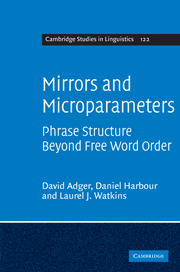Book contents
- Frontmatter
- Contents
- List of tables
- Acknowledgements
- Abbreviations and notation
- Kiowa phonemes and orthography
- 1 Introduction
- 2 Nonconfigurationality and polysynthesis
- 3 The clausal spine
- 4 Making mirrors
- 5 Interface properties of clausal domains
- 6 Anti-quantification and the syntax–semantics interface
- 7 Conclusion
- Appendix
- References
- Index
5 - Interface properties of clausal domains
Published online by Cambridge University Press: 26 January 2010
- Frontmatter
- Contents
- List of tables
- Acknowledgements
- Abbreviations and notation
- Kiowa phonemes and orthography
- 1 Introduction
- 2 Nonconfigurationality and polysynthesis
- 3 The clausal spine
- 4 Making mirrors
- 5 Interface properties of clausal domains
- 6 Anti-quantification and the syntax–semantics interface
- 7 Conclusion
- Appendix
- References
- Index
Summary
Introduction
In the previous chapters, we established a functional hierarchy and a theory of phrase structure that explains many facts about constituent and morpheme order in Kiowa. Amongst these was an account of rigidity of order in the postverbal domain. What we have not explained so far is the freedom of word order in the preverbal domain (i.e., the entire stretch of the sentence before the verb, including material which occurs before and after the particles). We suggest in this chapter that this freedom arises via movement (from the site of base generation inside the verb phrase) and that such movement is broadly motivated by information-structural considerations. We will see that, in contrast to postverbal elements, some preverbal DPs can be construed as being moved to their surface position. For those that are so moved, that position correlates with special information-structural status.
However, closer inspection of one of these apparent targets of movement (the pre-wh position) reveals a semantically consistent set of constraints. Curiously, exactly the same set of constraints holds of postverbal elements, a fact which is surprising given the deep syntactic differences between these positions. Their explanation is the topic of the next chapter.
In section 5.2, we apply the theory of the last chapter to show how selective particles and wh-movement permit the identification of the higher functional domain of the clause. We further show that preparticular elements have special information status, while postparticular but preverbal elements appear to be informationally neutral.
- Type
- Chapter
- Information
- Mirrors and MicroparametersPhrase Structure beyond Free Word Order, pp. 131 - 152Publisher: Cambridge University PressPrint publication year: 2009

